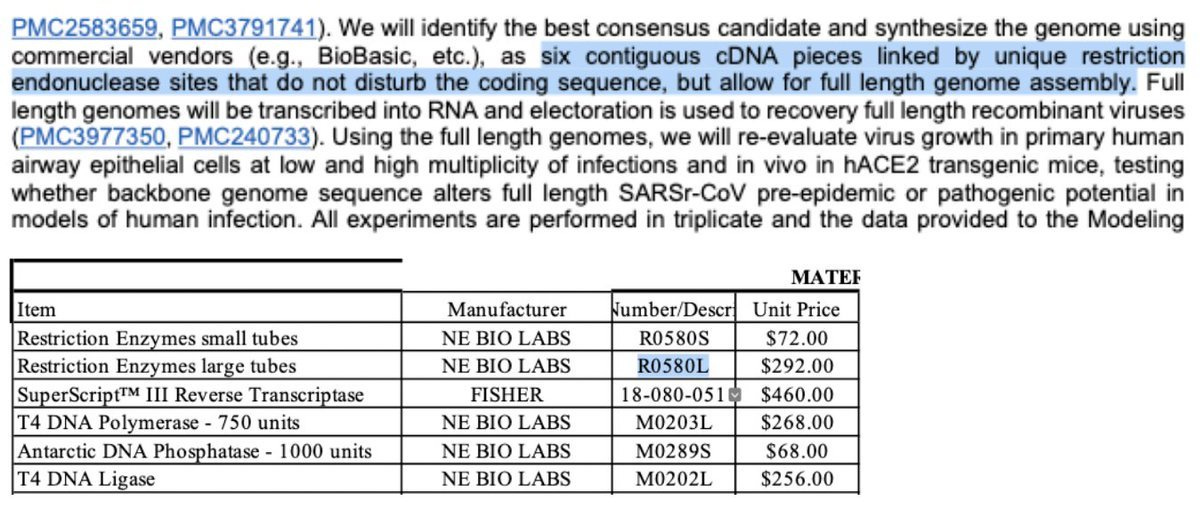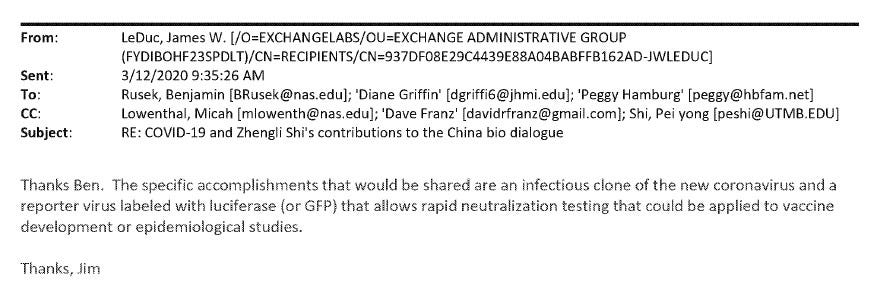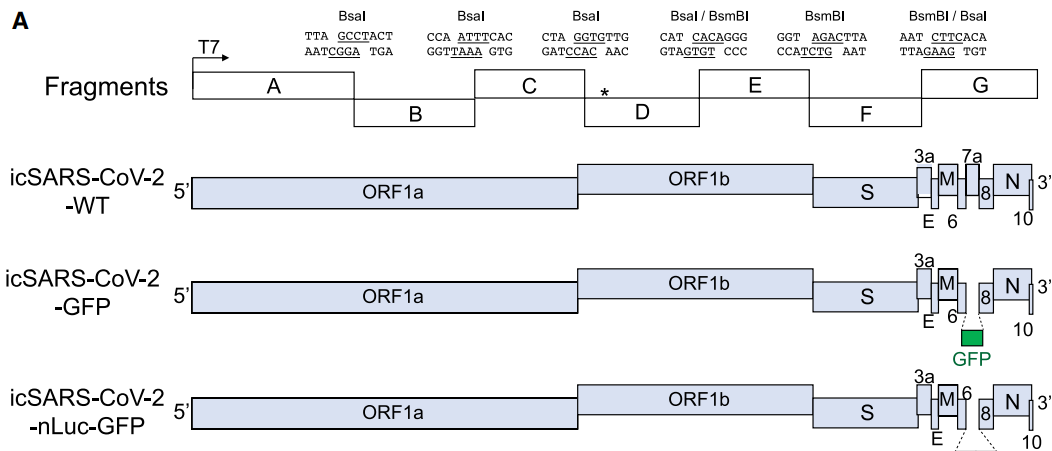How Baric tricked US intel
by chopping up the SARS2 genome
U.S. Right to Know published another great FOIA find. This one was from the Defense Intelligence Agency (DIA), which is like the CIA but for the Pentagon. They identified the SARS2 restriction sites before anyone else in the lab leak debate.
Restriction sites act like molecular scissors and glue to engineer large coronavirus genomes (~30,000 nucleotides). Virologists break the large genome into smaller fragments (5-10) to make them easier to handle and manipulate.
Extracted from the USTRK article with my [comments]:
The DIA analysis also points out that the Wuhan lab has “a large bank of Bat Coronaviruses” and that most sequences have not been published. [It is biologically impossible to publish anything closer than RaTG13]
DIA proceeded to show two different ways that the novel coronavirus could have been constructed using a type of engineering called Golden Gate Assembly – a method the Wuhan lab had the knowledge, experience, and resources to use. [Baric testified otherwise]
One method could have used a curious feature of the virus’s genome – two restriction sites that are spaced at a distance along the genome that could be useful for cloning. These sites – called BsmBI and BsaI – are commonly used in reverse genetics. Both sites had previously been used by the Wuhab lab to create chimeric coronaviruses, which are hybrids pieced together from sections of different coronaviruses.
A preprint published in 2022 showed that the distances between the BsmBI and BsaI sites in SARS-CoV-2 are indeed unusual, and “extremely unlikely in wild coronaviruses and nearly universal in synthetic viruses.”
The second method uses invisible restriction sites that would leave no trace of genetic manipulation.
The DIA analysis cites a May 2020 University of Texas [UTMB] publication, which demonstrates how quickly virologists could synthesize an infectious SARS-CoV-2 clone using such invisible restriction sites. Cutlip and Chretien’s [of Dod] working paper even stated that several labs had synthesized SARS-CoV-2 “within weeks” of its genome being published.
Both construction strategies would have been compatible with a fast and cheap reverse genetics method published by the Wuhan lab in 2016, where mutations could easily be introduced into coronaviruses.
The only labs that synthesized SARS2 “within weeks” were four labs that have been working on coronaviruses for decades (Drosten’s affiliated German lab, Japan, UTMB Galveston, UNC). Notably, Shi Zhengli of the Wuhan Institute of Virology never published a SARS2 reverse genetic system because she could not do so.
Shi never had a SARS2 infectious clone (i.e., lab-made version). James LeDuc from UTMB-Galveston offered to send her one. Shi’s WIV1 molecular clone used 7-10 fragments (A, B, C1, C2, D, E, F, G), as shown in the DIA report:
Shi’s reverse genetic system led to the subtitle of my book: But it’s not Chinese junk. Shi's 2017 paper describes a 25% recovery rate of a shuffled spike into an existing WIV1 backbone (I’ve called it a used Yugo).
Baric testified that Shi used baculovirus technology (bacterial artificial chromosome or BAC), which left a “sequence signature” based on the WIV1 molecular clone (closer to SARS1 than SARS2). Baric said Shi doesn’t use type IIS restriction sites like his cDNA system (I call Baric’s system a fast Ferrari vs Shi’s used Yugo).
Baric testified, “We think our [UNC] approach is safer because we've divided the genome into six pieces,” just like SARS-CoV-2. Baric’s latest 2017 system could preassemble six fragments like SARS2 in a BSL2, hence the five restriction sites.
The five type IIS restriction sites (BsmBI, BsmBI, BsmBI, BsaI, BsaI) in the SARS-CoV-2 genome yield six fragments (A, B, C, D, E, F), as documented by Bruttel et al. When Bruttel et al. was published, the three scientists mistakenly assumed Shi used cDNA. Shi cannot produce this since her genome would have 7 or more fragments. More fragments are required for genome stability with a lower-quality engineering system.
On March 5, 2020, U.S. government biodefense officials asked Baric in the Red Dawn emails whether SARS-CoV-2 contained “any restriction sites” suggesting genetic engineering. Baric responded, “No, there is absolutely no evidence of genetic engineering.”
Remember, if a virus is engineered, wherever it spilled over into the human population (e.g., WIV) doesn’t tell us where it was engineered (e.g., UNC). But the important part of the above is repeated below:
The DIA analysis cites a May 2020 University of Texas [UTMB] publication, demonstrating how quickly virologists could synthesize an infectious SARS-CoV-2 clone using such invisible restriction sites.
The DIA aligned the SARS2 fragments from Wuhan with the published results from UNC and UTMB-Galveston.
Notice the 6 fragments in SARS2 (top) versus the 7 fragments (bottom). When Baric recreated the SARS2 genome, he obviously recognized the 5 restriction sites he had left in the genome. Baric left the restriction sites in the SARS2 genome for future modifications (RBD, FCS, spikes, etc). No See’m biotech or scarless engineering is a “one-time use,” especially with a 30,000-nucleotide genome. So, what leaked was Baric’s prototype.
In early 2020, Baric coordinated with his longtime postdoc, Vineet Menachery, now at UTMB-Galveston, Texas (i.e., Xie et al.)
Baric and Menachery performed the same engineering strategy, placing a new restriction site between every existing site. Even the small fragment (D way above) of ~600 nucleotides (out of 30,000) got a new restriction site. There were six fragments in SARS2, but Baric and Menachery created seven fragments (F1 to F7).
This is the Twitter thread & LeDuc is Menachery's new UTMB boss.
Both Baric and Menachery did a switcheroo: where SARS2 has BsmBI sites, they use BsaI sites. Where SARS2 has BsaI sites, they use BsmBI sites. For the switcheroo method to work, they must place a site between these two, cutting fragment 4 (D way above) with BsaI and 5 (E) with BsmBI. Both groups do this: Menachery places its site at 17591, and Baric places its site at 17840. Both cut F4 (D) with BsaI and F5 with BsmBI/Esp3I. Given the precise placing of this cut, it strains belief to think neither group had mapped out the BsmBI and BsaI sites already in SARS2.
The DIA scientists noticed that the five SARS2 restriction sites created six fragments but couldn’t tie them to Baric’s reverse genetic system. Baric even planned to use six fragments in the 2018 DARPA Defuse documents.


Baric’s Defuse draft didn't specify 5-7 fragments, but 6, which suggests that he already knew which sequence he would use in 2018. Baric used 6 fragments before 2020:
Above is Baric’s pre-pandemic work, but below is Baric’s 2020 work with seven segments.
brilliantly tweeted about Baric’s post-pandemic cover-up:What Baric did here is a bit weird. Despite already having a type IIs site distribution in the SARS2 genome that should absolutely work to add a GFP, he selected very different stitching sites. He used "no see'm" cloning, which requires a complete assembly of each variant.
Now, you could argue that this proves that cloning is the better method, and that could be true if one wants to make only 2 variants and not screen possibly an entire library of RBMs.
You could also argue that it would look very weird if they published the first reverse genetics system made by introducing zero instead of 5-8 synonymous mutations. But they should have noticed and could have discussed this. Or we got it wrong, but how?
In other words, what emerged in Wuhan perfectly fit Baric’s cDNA reverse genetic system. It was Baric’s 2019 key in the SARS2 lock. Six segments would align perfectly with their existing UNC system. But Baric knew someone like DIA or Bruttel et al. would look closely at his system, so he covered his tracks. Baric’s only alibi during six hours of testimony was his greatest confession:
And [Bruttel et al] is a pathetic piece of work. By the way, you can see how I engineered the SARS-CoV-2 genome since it was published, and it’s completely different than this.
If Baric had reconstructed the SARS2 genome without modifications, someone like DIA would have noticed and suspected his involvement. An anonymous review of Bruttel et al. was more to the point:
“The authors should consider discussing the 2018 DEFUSE proposal, which proposes the construction of a reverse-genetic system from novel SARS-like coronaviruses similar to the reverse-genetic system that the authors propose here to have resulted in SARS-CoV-2.”
The reviewer reads like an anonymous whistleblower:
For example, the Baric lab established a seamless reverse-genetic system for constructing the SARS2 genome early in the pandemic using BsaI and BsmBI (Hou et al., 2020). Note that this reverse-genetic system does not use the BsaI/BsmBI sites present in the SARS2 genome but rather BsaI/BsmBI sites that are clipped out before genome fragment ligation.
Notice that Baric’s 2019 SARS2 genome resembles Baric’s HKU3-Smix patent (a.k.a. SARS2). From Chapter 22, The Chimera from America:
Baric puff piece
Baric didn’t comment, but high-profile UNC lobbyist did speak:
UNC-Chapel Hill lobbyist Kelly Dockham said she believes that Baric’s work studying viruses will continue to receive support, in part because of what she said was strong backing within the state.
Dockham said she’s spoken with legislators over the past several years about the need for better antivirals. Former Sen. Richard Burr, now a lobbyist for UNC-Chapel Hill and Duke, championed multiple pandemic preparedness initiatives while in office, and current Sen. Thom Tillis has pushed for increased NIH funding over the last two Congresses.
Tillis “is very uniquely positioned and aware of the significance that this money provides for the entire state,” Dockham told The Assembly.
Wuhan military games
Seven U.S. military members contracted Covid-like symptoms in Wuhan from October 18–27, 2019. Most Wuhan Military Game venues were northwest of the Yangtze River, about 30 km from Dani Anderson’s lab.
Dani’s BSL4 was so remote (red box) that it’s off the Congressional report map. Her dorm room and Shi’s BSL2 are near the red X. I still see the Wuhan games (scheduled in ~2015) as an ill-timed superspreader event: a bizarre coincidence.
French lab leak documentary
Requires French VPN:
https://www.france.tv/france-5/le-monde-en-face/7021906-covid-le-secret-des-origines.html
French letter for lab leak enquiry:
https://x.com/Tantalite/status/1909885220125360248
Dutch book reviews round 2
https://deanderekrant.nl/lablek-speurders-twisten/
German lawsuits
In February 2022, Roland Wiesendanger criticized Christian Drosten, a superstar scientist and Angela Merkel's official advisor, in an interview. In his view, the German virologist had "deliberately misled the public" by claiming that any suggestion of a lab leak was a conspiracy theory. Following these statements, Christian Drosten sued Wiesendanger for defamation, partially winning the urgent procedure. Since then, the two researchers have been preparing for a full trial…
However, shortly after, The Lancet magazine published a statement signed by many researchers, including Christian Drosten, comparing the laboratory hypothesis to a "conspiracy theory." At the same time, Shi Zhengli, the coronavirus specialist at the Wuhan Institute of Virology, published an article in the journal Nature in which she presented the genome of the new virus by specifically omitting its "furin site," a characteristic that makes it more contagious, and which is likely to have been modified in the laboratory.
I emailed Prof Wiesendanger and told him about Shi’s RaTG13 vs the SARS2 alignment kickstarting the February 1, 2020, teleconference involving Drosten.
NSYECDIPIGAGICASYQTQTNS_____RSVASQSIIAYTMSLGAENSVAYS (RaTG13)
NSYECDIPIGAGICASYQTQTNSPRRARSVASQSIIAYTMSLGAENSVAY (SARS2)
He replied, Shi is guilty for hiding the furin cleavage site. Shi didn’t hide the furin cleavage site; she exposed it by publishing RaTG13. The lab leak debate can even confuse German physicists.
Ebright lying?
He was grooming the USTRK reporter long ago. He called Linfa Wang a liar for claiming Baric proposed the furin cleavage site. Baric admitted it was his idea during testimony.
of mice and women
Alina Chan writes under the title, “I still believe my Covid lab theory was the right one – and it could happen again.” Yet, takes a shot at another lab leak book?
Our book (Viral) was meticulously fact-checked and has more than 300 references so that readers can look into the evidence surrounding the origin of the pandemic.
Alina wrote in her book, “Could [Covid] have acquired its skill in a lab, dwelling in the cell cultures derived from the human respiratory tract, or even in humanised mice?” Four of those 300 references were to humanized mice experiments. Her book mentioned lab mice 50 times, but Covid has zero to do with humanized mice.
Egyptian fruit bats
While Covid doesn’t infect humanized mice (or raccoon dogs), it does transmit in U.S. lab bats. Alina’s article mentioned Vincent Racaniello’s line from TWIV, “If it turned out to be true [that the pandemic virus was a lab construct], that would bother the hell out of me, not just because of people dying and so forth, but it's kind of an indictment of the field, right?”
Racaniello was an important part of my book. In a 2022 TWIV, he confirmed that Tony Schountz of Colorado State University (CSU) keeps DARPA’s Egyptian fruit bat colony while discussing bat research with Vincent Munster’s postdoc, Michael Letko.
Because of this logistical quirk, we could read the smoking gun email; if the bats were raised onsite at RML, it’s hallway talk. DARPA paid CSU nearly $10,800 annually to breed Egyptian fruit bats and ship them to Munster’s BSL4 Rocky Mountain Lab.
In other words, DARPA inadvertently funded the creation of Covid. DARPA-funded researcher Letko also worked on DARPA Defuse-type experiments in 2018-19. Notice how much cheaper Munster’s transmissible technology ($8M) was versus Baric’s ($14M).
Letko and Munster even used Fauci’s controversial EcoHealth grant (R01AI110964) to fund research on “vaccination of humans or reservoirs or intermediate animal hosts, as well as other measures to reduce the risk of contact and viral transmission at the animal–human interface.”
Their Egyptian fruit bats came from Catoctin Zoo near Washington, D.C., and were used by Baric and Munster to create Covid.














There’s so much evidence pointing towards a laboratory origin of the SARS-CoV-2 virus 🦠, especially today.
Why can’t (won’t?) those with the required legal expertise tackle this through a lawsuit?
Thanks for sharing this 🙏